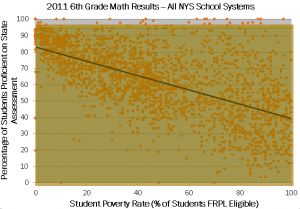Our Mission
Think of the achievement gap you most want to close: the gap between rich and poor; the gap between what students think and what they can write; the gap between schools in the US and the best school systems in the world; the gap between what our schools offer and what they could be.
The gap you just imagined can be closed. In fact it has been closed somewhere already, at the scale of one or maybe ten classrooms, the solutions discovered and implemented by some teacher in a classroom with too little of X and too much of Y, down an unmarked hallway in the last school you’d ever guess. But she did it anyway, that teacher. The tools she, and colleagues like her, developed are being used even as you read this in some classroom somewhere—across the country, across the state, or across the hall, to change the lives of students. The only problem is we don’t seek them out and study them with the humility their work deserves.
Teach Like a Champion is about the belief that the solutions to education challenges exist in the classrooms of real life teachers, that exceptional practitioners of the art of teaching are the true experts. Our job is to find them, study them, and share what they do, so others can copy, steal, practice and adapt it to their own teaching. On this site you’ll find resources to help you do that, to help you to get better faster, to help you love the process of studying teaching and learning and practicing, and to help you—above all—to love the work by doing it well.
In the Beginning
 It started with Doug, his notebook, and a set of questions: Which schools serving high need students are getting the best results? Which teachers in those schools are doing exceptional work? And what is it exactly
those teachers are doing? Directed by the data, Doug camped out in the back of these exceptional teachers’ classrooms to observe and seek to identify what they were doing that explained the trend-defying results they were getting. As Doug spent more time in these great teachers’ classrooms he began to notice some commonalities: this outstanding 3rd grade teacher in upstate New York—by ensuring that his students’ answers to questions always concluded with articulating the correct answer—was doing the same thing as that outstanding middle school English Language Arts teacher in New Jersey. Early on Doug realized that naming and describing these teacher moves would not only allow educators to talk about the craft of teaching more efficiently but that coupling description with short, focused video clips of the actual teachers with their students would allow the moves to be taught and learned. Yes, intuitively gifted teachers exist. By learning from, imitating, then adapting the specific, concrete actions of the best teachers, all teachers can become great.
It started with Doug, his notebook, and a set of questions: Which schools serving high need students are getting the best results? Which teachers in those schools are doing exceptional work? And what is it exactly
those teachers are doing? Directed by the data, Doug camped out in the back of these exceptional teachers’ classrooms to observe and seek to identify what they were doing that explained the trend-defying results they were getting. As Doug spent more time in these great teachers’ classrooms he began to notice some commonalities: this outstanding 3rd grade teacher in upstate New York—by ensuring that his students’ answers to questions always concluded with articulating the correct answer—was doing the same thing as that outstanding middle school English Language Arts teacher in New Jersey. Early on Doug realized that naming and describing these teacher moves would not only allow educators to talk about the craft of teaching more efficiently but that coupling description with short, focused video clips of the actual teachers with their students would allow the moves to be taught and learned. Yes, intuitively gifted teachers exist. By learning from, imitating, then adapting the specific, concrete actions of the best teachers, all teachers can become great.
Doug named the collection of techniques The Taxonomy of Effective Teaching Practices—to communicate the heuristic benefits of classification and to signal the parallel to artists who start with a humble set of tools and fundamental technique and then, once mastered, create beautiful, original art. As Norm Atkins has described elsewhere, in the early days, the twenty-page document was passed around from teacher to teacher, school leader to school leader, like samizdat. For old-school users of Doug’s work, the Teach Like a Champion techniques are still called “The Taxonomy.” Encouraged to formalize the techniques in a book, Doug wrote Teach Like a Champion . In March 2010, the publication of the book and a cover story that ran in The New York Times Magazine resulted in an explosion of interest.
Teach Like a Champion Today
 After several years of serving as a Managing Director overseeing Uncommon Schools in upstate New York while simultaneously designing and leading workshops for educators, Doug shifted to focus exclusively on the Teach Like a Champion
effort in 2012. He now leads a team of Uncommon educators continuously studying and describing great teaching, breaking that greatness down into concrete, replicable actions, then designing the training to make it manageable and accessible. We believe that all teachers can learn the sometimes deceptively simple, concrete actions that allow the achievement gap to be narrowed lesson by lesson, classroom by classroom in the United States and around the world.
After several years of serving as a Managing Director overseeing Uncommon Schools in upstate New York while simultaneously designing and leading workshops for educators, Doug shifted to focus exclusively on the Teach Like a Champion
effort in 2012. He now leads a team of Uncommon educators continuously studying and describing great teaching, breaking that greatness down into concrete, replicable actions, then designing the training to make it manageable and accessible. We believe that all teachers can learn the sometimes deceptively simple, concrete actions that allow the achievement gap to be narrowed lesson by lesson, classroom by classroom in the United States and around the world.




